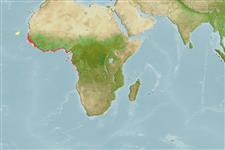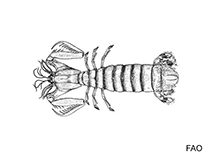Lysiosquilla hoevenii (Herklots, 1851)
Lizard mantis| Native range | All suitable habitat | Point map | Year 2050 |

|
| This map was computer-generated and has not yet been reviewed. |
| Lysiosquilla hoevenii AquaMaps Data sources: GBIF OBIS |
Google image | No image available for this species;
drawing shows typical species in Lysiosquillidae.
Classification / Names Populärnamn | synonymer | CoL | ITIS | WoRMS
Malacostraca | Stomatopoda | Lysiosquillidae
Environment: milieu / climate zone / djupintervall / distribution range Ekologi
; djupintervall 0 - 30 m (Ref. 436). Tropical
Distribution Länder | FAO områden | Ekosystem | Förekomster | Utplanteringar
Off West Africa, from the Cape Verde Islands; Senegal to Angola.
Length at first maturity / Size / Weight / Age
Könsmognad: Lm ? range ? - ? cm Max length : 27.0 cm BL hane/ej könsbestämd; (Ref. 417); common length : 20.0 cm BL hane/ej könsbestämd; (Ref. 436)
Short description Morfologi
Life cycle and mating behavior Könsmognad | Reproduktion | Lek | Eggs | Fecundity | Larvae
Main reference
referenser | Koordinator | Medarbetare
Schneider, W. 1990 FAO species identification sheets for fishery purposes. Field guide to the commercial marine resources of the Gulf of Guinea. Prepared and published with the support of the FAO Regional Office for Africa. Rome: FAO. 268 p. (Ref. 417)
IUCN Red List Status
(Ref. 130435: Version 2025-1)
CITES status (Ref. 108899)
CMS (Ref. 116361)
Threat to humans
Human uses
| FishSource |
Verktyg
Ytterligare information
Födosammansättning
Födointag
Predatorer
Max. ages / sizes
Length-weight rel.
Length-length rel.
Length-frequencies
Mass conversion
Abundans
Internet-källor
BHL | BOLD Systems | CISTI | DiscoverLife | FAO(Publication : search) | Fishipedia | GenBank (genome, nucleotide) | GloBI | Gomexsi | Google Books | Google Scholar | Google | PubMed | Tree of Life | Wikipedia (Go, sök) | Zoological Record



